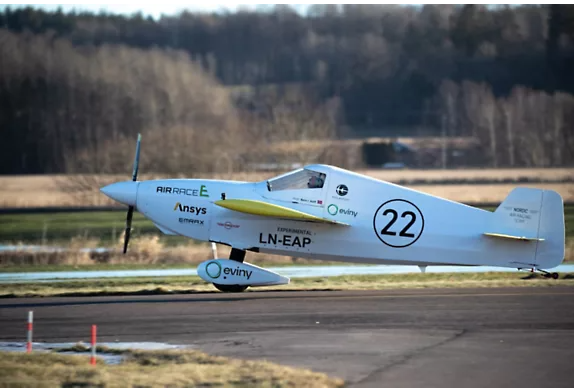Ansys Propels First Flight by Air Race E Electric Race Plane
The Nordic Air Racing Team uses Ansys simulation solutions in completing a historic step toward new era of aviation
Key Highlights
- Ansys is the official simulation software partner of Air Race E, an all-electric airplane racing series
- The Nordic Air Racing Team, competing in Air Race E, used Ansys multiphysics simulation solutions to optimize aerodynamics, cooling systems, and battery design and performance before executing the demonstration flight
The Nordic Air Racing Team, an official Air Race E team, successfully completed the world’s first flight of an all-electric racing plane – the plane was designed and engineered with the help of Ansys (NASDAQ: ANSS) simulation solutions. As the official simulation software partner of Air Race E, Ansys enables teams to overcome some of the key engineering challenges of fully electric flight.
Air Race E, the world’s first and only all-electric airplane racing championship, is a competitive platform that will accelerate the development of more electric and fully electric propulsion for aerospace applications. These technological advancements are critical for the aviation industry as companies and countries around the world work to reduce carbon emissions — especially those related to travel.
The competing teams are racing to prove their planes are airworthy in advance of the official Air Race E series, which launches in 2023. The Nordic Air Racing Team used Ansys software along with the Ansys Learning Hub, and collaborated with Ansys technical experts to reduce the overall project lead time by 40%.
“This first manned electric Air Race E race plane flight is a historic moment and a landmark achievement in the aviation industry,” said Jeff Zaltman, CEO at Air Race E. “It’s the culmination of months of planning, designing, concept developing, testing and manufacturing by the engineers — none of which could have been achieved without the support and expertise of Ansys and our other visionary partners. Everyone at Air Race E is extremely proud to be part of the burgeoning electric vehicle revolution, and we are grateful to Ansys for their role in making this defining milestone possible.”
Engineers on The Nordic Air Racing Team used Ansys multiphysics simulation solutions as they retrofitted a piston engine racing aircraft with an electric powertrain. Ansys was also used to modify the nose of the plane, optimize the center of gravity, air cooling system and aerodynamics, and develop the composite motor compartment.
“Ansys simulations made us feel extremely confident about our aircraft and shortened the timeline to achieving our first flight,” said Sathvik Rao, an engineer for The Nordic Air Racing Team. “I was surprised to see how Ansys software can integrate each and every parameter requirement for a system as complex as our battery. Without simulation in the early stages, our team would have had approximately 250 additional hours of experimental work around the battery pack’s heat dissipation and propagation.”
The Nordic Air Racing Team is one of seven official teams currently registered to compete in Air Race E. The official racing series involves up to eight small propeller airplanes taking off simultaneously, flying at 30 feet at speeds of 250 mph. It is the only motorsport of its kind.
“Competitions in motorsport have a habit of leading to exciting technological breakthroughs,” said Shane Emswiler, senior vice president of products at Ansys. “The Nordic Air Racing Team’s first flight is a testament to that, and to Air Race E’s incredible work in gathering all of the building blocks necessary for innovation. We’re honored to have been a part of this milestone and look forward to being a part of future advancements that allow aviation to reduce its reliance on fossil fuels.”
This content was first published on the Ansys website.


